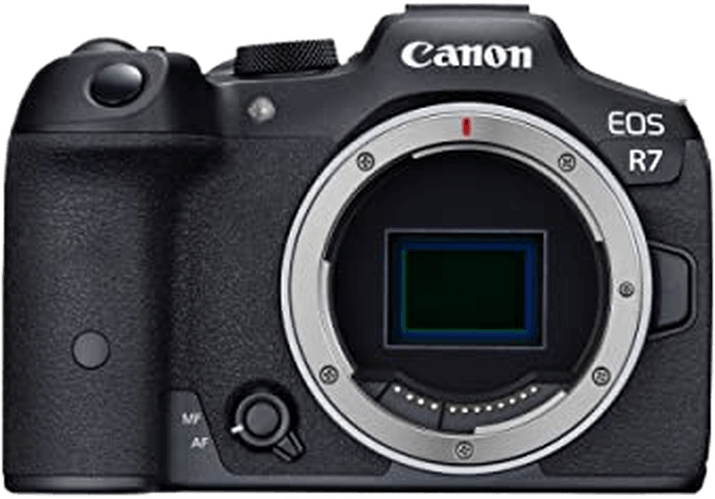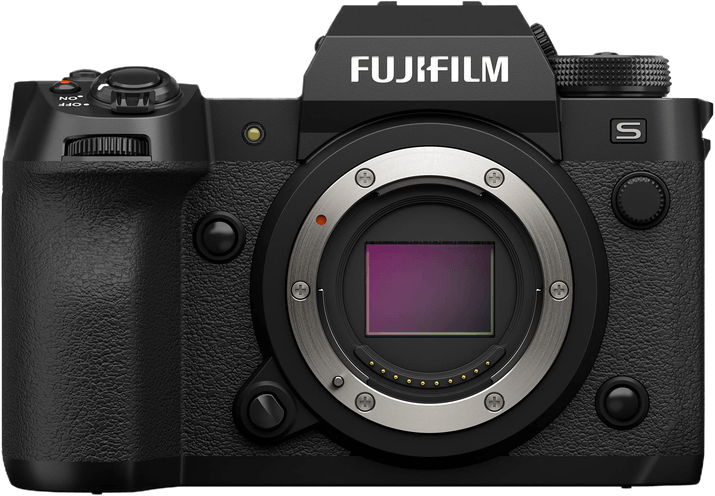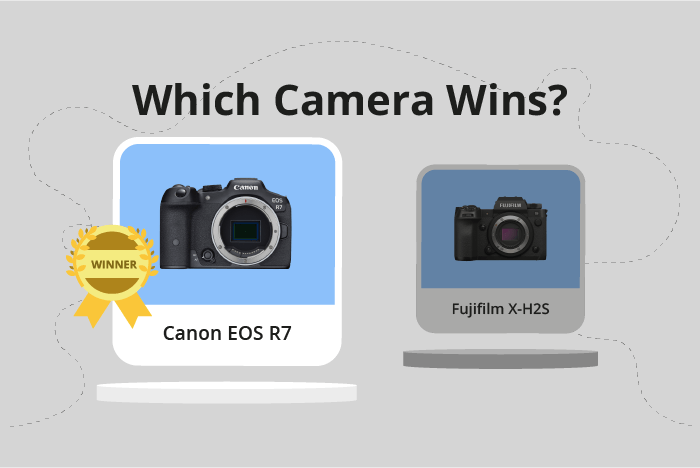Canon EOS R7 vs Fujifilm X-H2S Comparison
Canon EOS R7

Fujifilm X-H2S

The Canon EOS R7 emerges as the winner with a score of 83/100, while the Fujifilm X-H2S trails slightly behind at 79/100. Both cameras are mirrorless and were announced in May 2022. They share similar dimensions, with the EOS R7 measuring 132 x 90 x 92mm and the X-H2S at 136 x 93 x 95mm.
The EOS R7 outperforms the X-H2S in terms of price and weight, costing $1500 and weighing 1.35lbs, whereas the X-H2S is priced at $2500 and weighs 1.46lbs. This makes the Canon EOS R7 a more affordable and lightweight option for photographers.
On the other hand, the Fujifilm X-H2S has its merits, but they don’t outweigh the advantages of the EOS R7. The higher price and weight might be justified by specific features or specs not discussed here.
In the end, the Canon EOS R7 proves to be a better camera with its higher score, more budget-friendly price, and lighter build, while the Fujifilm X-H2S falls short in these areas.
Canon EOS R7 vs Fujifilm X-H2S Overview and Optics
The Canon EOS R7 outperforms the Fujifilm X-H2S in the optics department with a score of 82/100 compared to the X-H2S’s 77/100. Both cameras share common features such as the CMOS sensor type, APS-C sensor size, and image stabilization. Additionally, they both have dedicated lens mounts with the Canon using the RF mount and the Fujifilm utilizing the X mount.
The EOS R7 has an advantage in terms of megapixels, boasting 33 compared to the X-H2S’s 26. This results in higher resolution images and improved detail. The Canon also has a superior processor, the Digic X, which contributes to better image processing and overall performance. The EOS R7 also has a DXOMARK score of 97 for its sensor, highlighting its quality and performance. However, it is important to note that DXOMARK does not score Fujifilm cameras, so a direct comparison is not possible.
On the other hand, the Fujifilm X-H2S has a significantly faster shooting speed of 40, compared to the EOS R7’s 15. This makes the X-H2S more suitable for capturing fast-moving subjects and action photography.
Considering these factors, the Canon EOS R7’s higher megapixel count and superior processor make it a better option for those seeking high-resolution images and improved image processing. The Fujifilm X-H2S, with its faster shooting speed, is better suited for action photography. Ultimately, the choice between these two cameras depends on the specific needs and preferences of the photographer.
Canon EOS R7 vs Fujifilm X-H2S Video Performance
The Canon EOS R7 outperforms the Fujifilm X-H2S in video capabilities, scoring 91 out of 100 compared to the X-H2S’s 83. Both cameras share some common specifications, such as 4K video resolution and built-in time-lapse functionality. However, there are significant differences that contribute to the EOS R7’s superior performance.
One major advantage of the Canon EOS R7 is its higher maximum video frame rate of 120fps, double the Fujifilm X-H2S’s 60fps. This allows the EOS R7 to capture smoother slow-motion footage and provides greater flexibility in post-production. Additionally, the EOS R7’s maximum video dimensions of 3840 x 2160 are suitable for most professional video requirements.
On the other hand, the Fujifilm X-H2S has a slightly larger maximum video dimension of 4096 x 2160, which could be beneficial in specific situations where the extra resolution is needed. However, this advantage is limited due to its lower maximum frame rate.
In terms of video performance, the Canon EOS R7 is the clear winner, offering a higher frame rate that allows for better slow-motion capture and more versatility in editing. The Fujifilm X-H2S’s marginally larger video dimensions do not compensate for its lower frame rate, making it less competitive in this area.
Considering these factors, the Canon EOS R7 is the superior choice for video capabilities, providing users with a more flexible and powerful tool for capturing high-quality video content. The Fujifilm X-H2S, while still a competent camera, falls short in comparison to the EOS R7 in this aspect.
Canon EOS R7 vs Fujifilm X-H2S Features and Benefits
The Canon EOS R7 and Fujifilm X-H2S both have a feature score of 85/100, making them equally competitive in terms of camera features. These cameras share several specifications, including a 3-inch screen size, 1,620,000-dot screen resolution, touchscreen capability, flip screen, and the absence of GPS. Both cameras also offer WIFI and Bluetooth connectivity.
Examining the Canon EOS R7, it stands out due to its superior autofocus system, which provides faster and more accurate subject tracking. This feature is especially beneficial for action and sports photography, where capturing fast-moving subjects is essential. The R7 also has a more extensive lens selection, giving photographers more flexibility and creative options in various shooting situations.
On the other hand, the Fujifilm X-H2S has a unique advantage in its film simulation modes, which emulate the look and feel of classic film stocks. This feature appeals to photographers who enjoy the nostalgia and aesthetics of analog photography without the hassle of shooting and developing film. Additionally, the X-H2S boasts a more compact and lightweight design, making it easier to carry around for extended periods.
Taking these points into account, the Canon EOS R7 is the better choice for photographers who prioritize autofocus performance and a wide range of lens options, while the Fujifilm X-H2S is more suited for those who appreciate film simulation modes and a lighter, more portable camera body. Ultimately, the decision between these two cameras comes down to individual preferences and priorities in photography.
Canon EOS R7 vs Fujifilm X-H2S Storage and Battery
The Canon EOS R7 wins the storage and battery comparison with a score of 79/100, while the Fujifilm X-H2S scores 76/100. Both cameras have two memory card slots and support USB charging. They also have UHS-II compatibility for faster writing and reading of data.
The Canon EOS R7 is better in terms of battery life, offering 660 shots per charge with its LP-E6NH battery. This is 80 shots more than the Fujifilm X-H2S, which provides 580 shots using its NP-W235 battery. The longer battery life makes the EOS R7 more suitable for extended shooting sessions.
The Fujifilm X-H2S, however, accepts CFexpress Type B cards in addition to SD cards, providing more versatile storage options. This advantage may appeal to photographers who prefer using CFexpress cards for their faster speeds and larger capacities.
Considering the storage and battery aspects, the Canon EOS R7 is the better choice due to its longer battery life. The Fujifilm X-H2S is still a strong contender with its diverse storage options, but its shorter battery life may limit its usability in certain situations.
Canon EOS R7 vs Fujifilm X-H2S – Our Verdict
Are you still undecided about which camera is right for you? Have a look at these popular comparisons that feature the Canon EOS R7 or the Fujifilm X-H2S:

